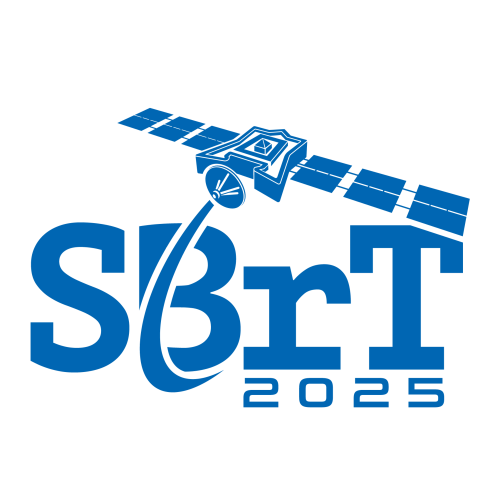
XLIII Simpósio Brasileiro de Telecomunicações e Processamento de Sinais

An Experimental O-RAN Environment for Evaluating AI-Driven RAN Control
Lucas Rodrigues, Elen C. R. Gomes, Glauco Estácio Gonçalves, Diego de Freitas Bezerra, Djamel Hadj Sadok
DOI: 10.14209/sbrt.2025.1571144362
Keywords: O-RAN 5G Beyond Near-rt-RIC Network Management
Abstract
Open RAN (O-RAN) aims to reduce operational costs and improve interoperability by promoting disaggregated and virtualized Radio Access Network architecture. In this context, development of new xApps is limited by the capabilities of underlying experimental platforms. This paper presents an experimental environment integrating srsRAN and OSC-RIC, two widely used open-source O-RAN software components, and extends srsRAN to expose additional performance metrics via the E2 interface. Such extension enables the periodic reporting of detailed KPIs from the PHY and MAC layers, enhancing RAN observability and offering a cornerstone for evaluating new xApps for closed-loop control and adaptive optimization in 5G networks.Download
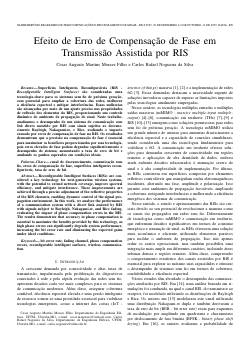
Efeito de Erro de Compensação de Fase em Transmissão Assistida por RIS
Cesar Augusto Martins Moraes Filho, Carlos R. N. da Silva
DOI: 10.14209/sbrt.2025.1571144589
Keywords:
Abstract
Superfícies Inteligentes Reconfiguráveis (RIS - Reconfigurable Intelligent Surfaces) são consideradas uma tecnologia-chave para os sistemas sem fio de próxima geração, com potencial para ampliar a cobertura das redes, melhorar a eficiência espectral e mitigar interferências. Essas melhorias são alcançadas por meio do controle dinâmico do ambiente de propagação do sinal, ajustando precisamente as propriedades de reflexão dos elementos da RIS. Neste trabalho, analisamos o desempenho de um link direto assistido por RIS com sinais sujeitos ao desvanecimento Rayleigh, Nakagami-m, e Rice, avaliando o impacto causado por erros de compensação de fase. Os resultados demonstram que a precisão na compensação de fase é essencial para maximizar os benefícios proporcionados pelas RISs, pois erros elevados podem degradar significativamente o desempenho do sistema, aumentando a taxa de erro de bit e anulando os ganhos esperados em condições ideais.Download

Data-Constrained Semi-Supervised Approaches for Optical Network Fault Detection
Adryele C. Oliveira, Giovana Nascimento Silva, Andrei Nogueira Ribeiro, Fabrício Lobato, Moisés Felipe Silva, Joao Weyl Costa
DOI: 10.14209/sbrt.2025.1571144607
Keywords: Optical Networks Machine Learning Failure Detection Reduced Training Data
Abstract
With the emergence of 6G and IoT systems, it becomes crucial to correctly detect faults in optical networks to guarantee access to these vital systems. Although machine learning approaches show promise, most demand large datasets, often scarce in practice, posing a significant challenge for model deployment. In this work, we evaluate three semi-supervised learning approaches specifically selected for their complementary strengths in data-scarce scenarios: Principal Component Analysis (PCA) for its noise-resistant dimensionality reduction, One-Class SVM (OCSVM) for its robust boundary learning with limited normal samples, and Hierarchical Clustering (HC) for its adaptability to network operation patterns. All models are trained exclusively on normal operation data and progressive data reductions to assess their performance in resource-constrained scenarios. Experimental results using optical testbed telemetry data show that PCA, OCSVM, and HC achieve accuracies of 93\%, 91.91\%, and 74.31\%, respectively, when trained with only 5\% (544 samples).Download
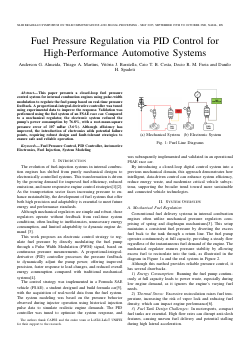
Fuel Pressure Regulation via PID Control for High-Performance Automotive Systems
Anderson Guerra Almeida, Thiago de Ávila Martins, Vitória Jacomelli Baratella, Caio Tácito Borges da Costa, Décio R Faria, Danilo Spadoti
DOI: 10.14209/sbrt.2025.1571144616
Keywords: Fuel Pressure Control PID Controller Automotive Electronic Fuel Injection System Modeling
Abstract
This paper presents a closed-loop fuel pressure control system for internal combustion engines using pulse-width modulation to regulate the fuel pump based on real-time pressure feedback. A proportional-integral-derivative controller was tuned using experimental data to improve the response. Validation was performed using the fuel system of an FSAE race car. Compared to a mechanical regulator, the electronic system reduced the pump's power consumption by 76.8%, with a root-mean-square pressure error of 107 mBar (3.6%). Although efficiency has improved, the introduction of electronics adds potential failure points, requiring robust design and fault-tolerant strategies to ensure safe and reliable operation.Download
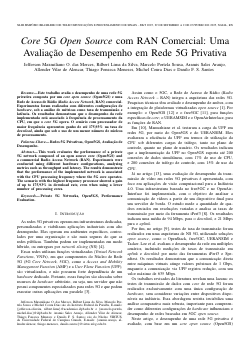
Core 5G Open Source com RAN Comercial: Uma Avaliação de Desempenho em Rede 5G Privativa
Jefferson Maxmiliano O. das Merces, Rilbert Lima da Silva, Marcelo Portela Sousa, Aramis Sales Araujo, Allender Alencar, Thiago Fonseca Meneses, Michel Dias, Danilo F S Santos
DOI: 10.14209/sbrt.2025.1571144617
Keywords:
Abstract
Este trabalho avalia o desempenho de uma rede 5G privativa composta por um core open source (Open5GS) e uma RAN comercial. Experimentos foram realizados com diferentes configurações de hardware, sob a análise de métricas como taxa de transmissão e latência. Os resultados demonstram que o desempenho da rede implementada está associado à frequência de processamento da CPU, em que o core 5G opera. O cenário com processador de maior frequência apresentou ganho de até 175,93% na taxa de download, ainda que sob o uso de um menor número de núcleos de processamento.Download

Implementing Network Slicing in 5G Transport Networks Using Programmable Switches
Heitor M Anglada, Raissa Cunha da Costa, Glauco Estácio Gonçalves, Cleverson Veloso Nahum, Silvia Lins
DOI: 10.14209/sbrt.2025.1571144623
Keywords: 5GC Network Slicing P4
Abstract
With the increasing complexity of 5G networks, flexible solutions are needed to ensure the requirements of each service. Network slicing isolates resources for different services, but there is no standard for end-to-end isolation in the transport network domain. This work explores using SDN and programmable P4 switches for network slicing in the transport domain. It presents a solution that accommodates various interconnections between the radio access and core network, evaluated in an experimental setup with Free5GC, UERANSIM, and Kathará. Results show the solution effectively maintains SLA requirements, enhancing flexibility in the 5G transport domain.Download
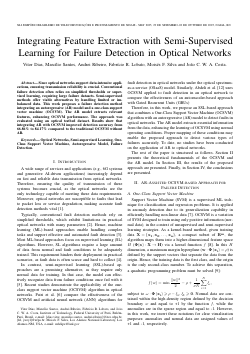
Integrating Feature Extraction with Semi-Supervised Learning for Failure Detection in Optical Networks
Vitor Rafael Oliveira Dias, Marcílio F Santos, Andrei Nogueira Ribeiro, Fabrício Lobato, Moisés Felipe Silva, Joao Weyl Costa
DOI: 10.14209/sbrt.2025.1571144674
Keywords: Optical Networks Semi-supervised Learning One-Class Support Vector Machine Autoregressive Model
Abstract
Since optical networks support data-intensive applications, ensuring transmission reliability is crucial. Conventional failure detection often relies on simplified thresholds or supervised learning, requiring large failure datasets. Semi-supervised methods offer viable alternatives by handling limited or imbalanced data. This work proposes a failure detection method integrating an autoregressive (AR) model and a one-class support vector machine (OCSVM). The AR model extracts relevant features, enhancing OCSVM performance. The approach was evaluated using an optical testbed dataset. Results show that integrating AR with OCSVM improved detection accuracy from 66.86% to 84.17% compared to the traditional OCSVM without AR.Download

Avaliação da Cobertura de Sinal 5G em Área Urbana de Mossoró Através do Uso de Interpolação Numérica Espacial
Pedro Arthur Freitas da Silva, Humberto Dionísio de Andrade Sr, Nickson S Oliveira Lopes
DOI: 10.14209/sbrt.2025.1571144682
Keywords:
Abstract
Advances in telecommunications have driven new technologies, such as 5G, which offers higher speeds and lower latency in data transmission. This study aims to measure and analyze signal strength levels based on RSSI in the 5G frequency band within an urban area of Mossoró, assessing signal power and its compliance with IEEE protocols and ANATEL regulations, using spatial interpolation methods and cross-validation. The results contribute to understanding the efficiency of network coverage and the challenges in implementing the technology.Download
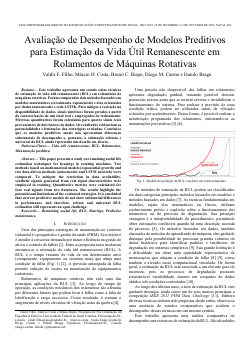
Avaliação de Desempenho de Modelos Preditivos para Estimação da Vida Útil Remanescente em Rolamentos de Máquinas Rotativas
Valdir Ferreira Filho, Marcio H Costa, Bruno C. Bispo, Diego Marques do Carmo, Danilo de S. Braga
DOI: 10.14209/sbrt.2025.1571144685
Keywords:
Abstract
This paper presents a study on remaining useful life estimation techniques for bearings in rotating machines. Two methods based on mathematical models (exponential growth) and two data-driven methods (autoencoder and LSTM network) were compared. To mitigate the restriction in data availability, synthetic signals generated from real signal characteristics were employed in training. Quantitative metrics were calculated for four real signals from two databases. The results highlight the potential and limitations of the evaluated strategies. It is concluded that current predictive models do not show substantial differences in performance, and therefore, robust, and universal RUL estimation still represents an open challenge.Download
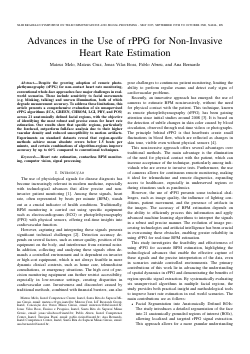
Advances in the Use of rPPG for Non-Invasive Heart Rate Estimation
Mateus Melo, Mateus Cruz, Jonas Lopes Vilas Boas, Pablo de Abreu Vieira, Ana Beraldo
DOI: 10.14209/sbrt.2025.1571144688
Keywords: Heart rate estimation contactless BPM monitoring computer vision signal processing
Abstract
Despite the growing adoption of remote photoplethysmography (rPPG) for non-contact heart rate monitoring, conventional whole-face approaches face major challenges in real-world scenarios. These include sensitivity to facial movements (e.g., blinking, talking) and uneven illumination, both of which degrade measurement accuracy. To address these limitations, this paper presents a comprehensive evaluation of six unsupervised rPPG algorithms (ICA, GREEN, CHROM, LGI, PBV, and POS) across 21 anatomically defined facial regions, aiming to identify the most robust and precise zones for heart rate estimation. Our results show that specific regions, particularly the forehead, outperform full-face analysis due to their higher vascular density and reduced susceptibility to motion artifacts. Experiments on standard datasets reveal that region-specific methods achieve mean absolute errors below 1.5 beats per minute (BPM), with certain algorithm-region combinations improving accuracy by up to 66% compared to conventional techniques.Download